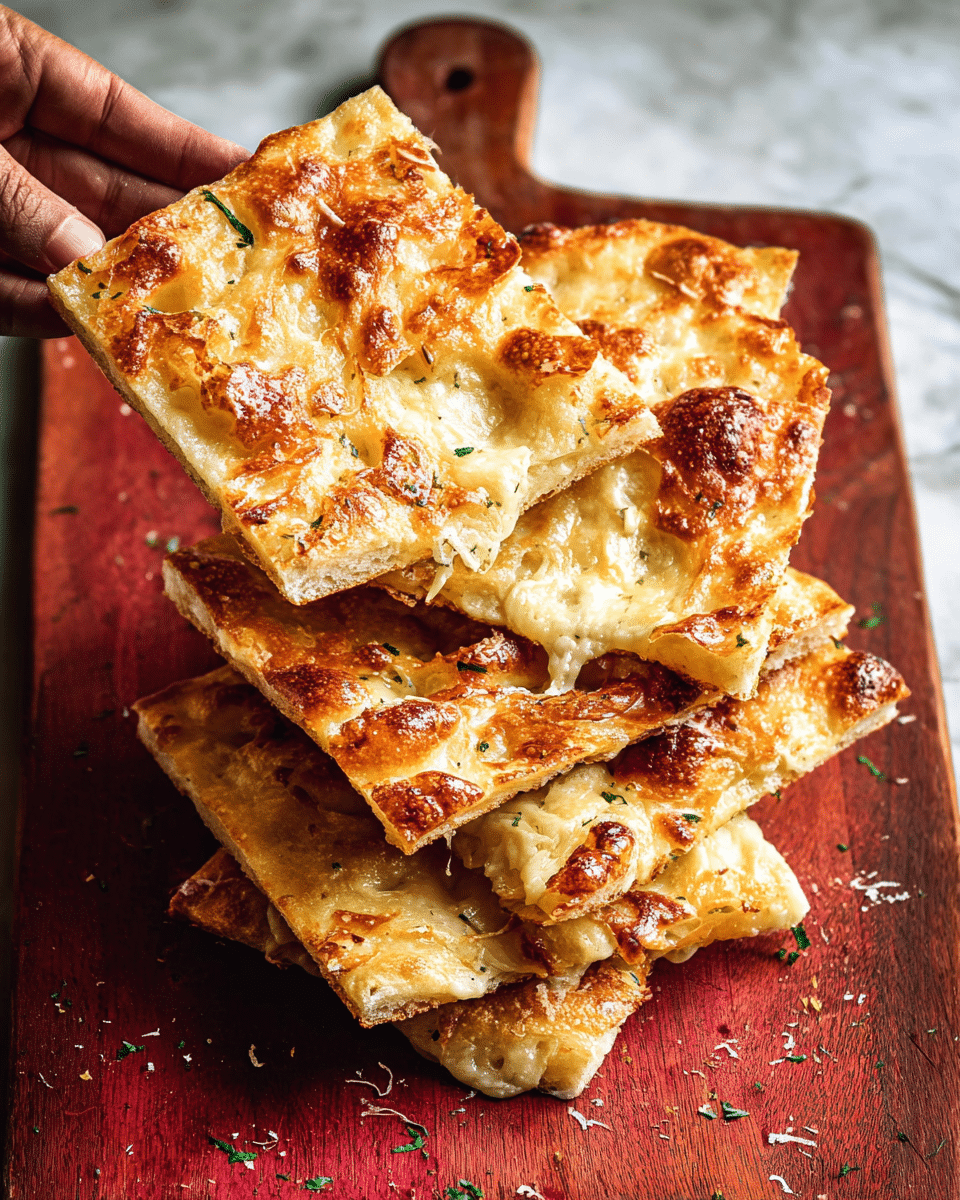Focaccia di Recco is a dish that immediately captures attention with its contrasting textures and indulgent filling. Unlike the fluffy, olive oil–dimpled focaccia many people are familiar with, this Ligurian specialty stands apart with its delicate paper-thin layers of dough and molten cheese core. Originating from the small coastal town of Recco, near Genoa, this flatbread has become a culinary icon, so beloved that it holds a Protected Geographical Indication (PGI) status in Italy. Its preparation is deceptively simple, requiring only flour, water, olive oil, and cheese, yet the result is luxurious and deeply satisfying. Biting into a slice reveals a crisp, golden exterior that shatters gently, giving way to creamy, tangy stracchino cheese that stretches and melts across the palate. Best enjoyed piping hot, it brings together rustic tradition and refined flavor in one irresistible package, making it both a treasured classic and a delightful discovery for those new to Ligurian cuisine.
Full Recipe:
Ingredients
-
250 g strong white bread flour, plus extra for dusting
-
½ tbsp caster sugar
-
1 tsp fine sea salt, plus a pinch
-
6 tbsp extra-virgin olive oil, plus extra for drizzling
-
150 ml lukewarm water
-
200 g stracchino cheese (or crescenza cheese)
-
1 shallow baking tray (about 20 × 30 cm)
Directions
-
Place the flour, sugar, salt, 2 tablespoons of olive oil, and lukewarm water in the bowl of a stand mixer fitted with a dough hook. Mix on low speed for about 5 minutes until a dough begins to form, then increase the speed to medium and continue kneading for 6–8 minutes until the dough is smooth and elastic.
-
If mixing by hand, knead on a lightly floured surface for 12–15 minutes until the dough feels soft but retains some stickiness.
-
Rest the dough for about an hour to allow it to relax, making stretching easier later.
-
Divide the dough into two equal portions. Roll one piece thinly and then gently stretch it by hand until almost translucent. Place this sheet on the prepared baking tray.
-
Spread the stracchino cheese evenly over the dough, leaving a small border around the edges.
-
Roll and stretch the second portion of dough until very thin, then drape it over the cheese filling to cover completely.
-
Press the edges of the dough layers firmly together to seal. Tear a few tiny incisions across the surface to allow steam to escape while baking.
-
Drizzle lightly with olive oil.
-
Bake in a very hot oven (around 500 °F / 250 °C) for 6–8 minutes until blistered, golden, and crisp.
-
Remove from the oven, cut into rustic pieces, and serve immediately while the cheese is still molten.
Nutrients
-
High in protein from the stracchino cheese
-
Provides calcium for bone health
-
Contains healthy monounsaturated fats from olive oil
-
Supplies carbohydrates for energy through the flour base
-
Moderate calories with a balance of fat, protein, and carbs
Why This Recipe Stands Out
This flatbread is remarkable for its originality and elegance. While most people expect focaccia to be thick, yeasty, and pillowy, Focaccia di Recco flips that assumption on its head. Its dough, made without yeast, bakes into a crisp, cracker-like shell that contrasts beautifully with the gooey, molten cheese sealed inside. This duality—light, crisp exterior and creamy, indulgent core—delivers a sensory experience unlike any other. It is also a dish rooted in place and tradition, carrying centuries of culinary heritage from the town of Recco, where it is protected by PGI recognition. This flatbread feels simultaneously rustic and refined, approachable to prepare yet sophisticated in its execution. With no rise time needed, it is quicker than most breads but still requires craftsmanship in handling the dough. Its drama comes not from complicated methods but from the beautiful contrast of textures and flavors that turn simple ingredients into an unforgettable dish.
The Benefits of the Ingredients
The charm of Focaccia di Recco lies in the careful role each ingredient plays. Bread flour, rich in protein, builds the elasticity needed for the dough to be rolled and stretched paper-thin without tearing. Sugar, used in small amounts, helps develop a golden crust in standard ovens, giving it visual appeal. Sea salt enhances taste and strengthens the dough, while olive oil lends a fruity depth of flavor, tenderizes the dough, and helps it crisp during baking. At the heart of it all is the stracchino cheese, a fresh, creamy, slightly tangy cheese that melts into a luscious, silky filling. Unlike firmer cheeses, it softens evenly without becoming greasy, providing a decadent but balanced indulgence. These ingredients are humble, yet when combined with care, they create a dish that feels indulgent, layered, and satisfying. The recipe is a perfect example of how Italian cooking relies on restraint and balance—nothing more than what is necessary, yet each element playing a vital role in the whole.
Cooking Tips
Achieving the ultra-thin dough that defines Focaccia di Recco requires patience and technique. The dough should first be rolled thinly, then carefully stretched by hand until almost translucent, much like handling delicate fabric. Allowing it to rest before stretching makes it more pliable and less likely to tear. When adding cheese, spread it evenly without overloading—too much filling can break through the dough, while too little won’t deliver the signature indulgence. Sealing the edges firmly ensures the filling stays enclosed, and cutting small slits on the surface allows steam to escape, preventing the dough from puffing uncontrollably. A generous drizzle of olive oil before baking enhances the crust’s color and crispness. The oven must be as hot as possible, ideally preheated to mimic traditional wood-fired baking, so the flatbread cooks quickly and evenly. Timing is crucial: bake just until the crust is blistered and golden, and the cheese inside is molten but not dried out. With these tips in mind, the flatbread emerges as crisp, bubbling, and irresistible.
Serving Suggestions
Focaccia di Recco is best eaten immediately, as soon as it leaves the oven, when the cheese filling is still molten and stretchy. Slice it into squares or rustic shards and enjoy while hot for the best texture. On its own, it makes a stunning centerpiece for a casual meal, but it also pairs beautifully with other foods. Serve it alongside a crisp green salad dressed with lemon for freshness, or with thinly sliced cured meats for a savory contrast. For a creative twist, drizzle with honey or aged balsamic vinegar to add a sweet note that cuts through the richness of the cheese. When paired with drinks, a sparkling wine like Prosecco or a chilled lager provides the perfect balance, cleansing the palate between bites. While leftovers can be reheated briefly, the flatbread is at its most enchanting fresh from the oven, when its texture and flavor are at their peak.
Conclusion
Focaccia di Recco is far more than a flatbread; it is an edible symbol of Ligurian tradition, skill, and simplicity. By combining just a few ingredients—flour, olive oil, water, salt, and stracchino—it achieves a luxurious outcome that feels both rustic and elegant. Its uniqueness lies in its paper-thin, crisp crust paired with a molten, creamy cheese center, a contrast that makes each bite memorable. Unlike yeasted breads that demand long hours of waiting, this recipe rewards immediacy, making it accessible while still requiring the finesse of delicate dough handling. Its PGI recognition speaks to its cultural importance and the pride of the town that gave it life. Whether enjoyed as the star of a casual meal, shared at a festive gathering, or savored with a glass of sparkling wine, Focaccia di Recco delivers indulgence, comfort, and tradition in one irresistible dish. Once tasted, it leaves a lasting impression, reminding us of the beauty found in simplicity and the joy of food that brings people together around the table.






